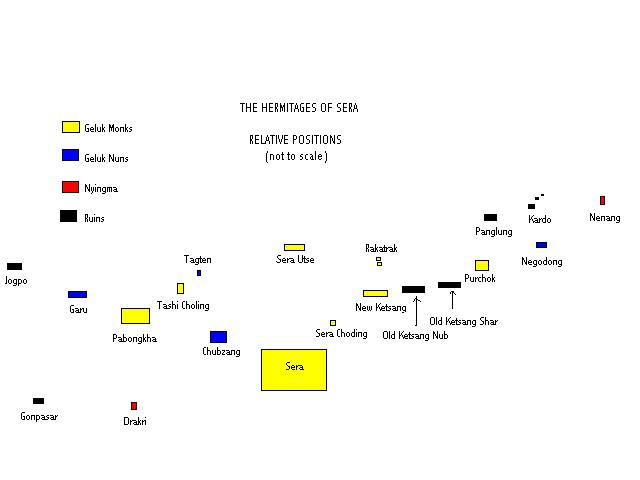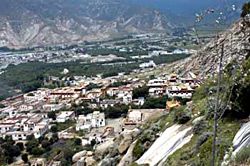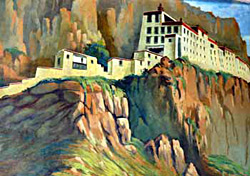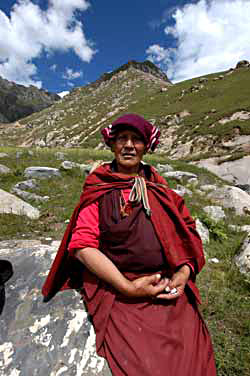by José Ignacio Cabezón and THL.
Location and Institutional Affiliation to SeraSe ra
Most of the SeraSe ra hermitages are located in the mountains to the north, east and west of the monastery along a (roughly) fifteen kilometers east-west span from Jokpo’Jog po and GönpasarDgon pa gsar hermitages in the far west to NenangGnas nang in the far east. The rough map that follows gives the relative location and some basic information about the hermitages of SeraSe ra as of 2004. The map operates on a usual north-south axis, with the mountains to the north of the hermitages and the city of LhasaLha sa to the south. The hermitages to the right (northeast) of SeraSe ra are located in what is today a suburb of LhasaLha sa known as Dodé.8 The hermitages to the left (northwest) of SeraSe ra are located in the suburb known as NyangdrenNyang bran.

In 1959, all of the hermitages on this map were thriving institutions. Two of them – NegodongGnas sgo gdong to the east, and GaruGa ru to the west – were nunneries. The rest were monasteries for male monks. They ranged in size from about ten to well over one-hundred monks or nuns. In the case of monks’ hermitages, it was not uncommon for there to have been a core group of six to eighteen fully-ordained monks (gelongdge slong) that is what gave the institution its formal status and legitimacy as a monastery. But all of the monasteries also had many novices, non-monastic lay workers and support staff. If the hermitage was also the seat of a labrangbla brang or lamabla ma’s estate/household, the support staff (including novices) could be three to four times as large as the number of fully ordained monks. For example, the Keutsang West Hermitage (Keutsang Nup RitröKe’u tshang nub ri khrod), the official residence of the Keutsang LamaKe’u tshang bla mas, had a core group of twenty-five fully ordained monks, but if one includes novices and non-monastic staff the population was closer to ninety.9
Of the nineteen SeraSe ra hermitages nine were the seats of lamabla mas – that is, they were the headquarters for lama’s estates. With two exceptions (noted below) the name of the lamabla ma lineage and that of the hermitage were identical. The lama’s estate hermitages were:
- Jokpo’Jog po
- GönpasarDgon pa gsar
- DrakriBrag ri
- Trashi ChölingBkra shis chos gling, since 1930 the seat of the Pabongkha TrülkuPha bong kha sprul skus
- Sera UtséSe ra dbu rtse, the seat of the Drupkhang TrülkuSgrub khang sprul skus
- Keutsang West
- PurchokPhur lcog
- PanglungSpang lung
- KhardoMkhar rdo

SeraSe ra as viewed from Chöding Hermitage (Chöding RitröChos sdings ri khrod).
Despite the fact that all of the hermitages are called “hermitage of Sera” (Seré ritröse ra’i ri khrod), their relationship to SeraSe ra is actually quite varied and often shifts over time. Some are related to SeraSe ra only insofar as they were founded by SeraSe ra monks, or because as they were taken over by SeraSe ra monks at some point in their history. In several cases, hermitages were independent institutions with only nominal ties to SeraSe ra. In other instances, hermitages were actually the property of SeraSe ra. In between these two poles – minimal affiliation to SeraSe ra at one extreme, and ownership by SeraSe ra at the other – there were a variety of kinds and degrees of affiliation. If the hermitage belonged to a SeraSe ra lamabla ma, then it was this lamabla ma, and not SeraSe ra, who owned the hermitage. But even then there could be different degrees of affiliation between SeraSe ra and the hermitage.
For example, in 1959 Keutsang West belonged to the Keutsang LamaKe’u tshang bla ma. All of the monks of the hermitage belonged to the Keutsang Lama’s estate (Keutsang LabrangKe’u tshang bla brang). But all of the official monks of KeutsangKe’u tshang were also official monks of the Hamdong Regional House (Hamdong KhangtsenHar gdong khang tshan) of Sera Jé College (Sera Jé DratsangSe ra byes grwa tshang), and enjoyed all of the privileges of being SeraSe ra monks with regional house affiliations.10 Purchok Hermitage (Purchok RitröPhur lcog ri khrod), by contrast, appears to have been much more independent, and had a weaker affiliation to SeraSe ra. PurchokPhur lcog monks belonged principally to the Purchok Lama’s estate (Purchok LabrangPhur lcog bla brang), and it appears that many (perhaps most) did not have official membership in either the Jé College or in one of its regional houses.

A painting of what Keutsang West Hermitage looked like before 1959.
To take another example, the nunneries11 of GaruGa ru and NegodongGnas sgo gdong belonged not to SeraSe ra but to the lama’s estates of the DrakriBrag ri and KhardoMkhar rdo lamabla mas, respectively, and these lamabla mas served as their abbots. It is clear, then, even from these few examples, that the question of the institutional relationships of these hermitages to SeraSe ra is a complex one. Because few elder monks from these various monasteries are still alive, it is a challenge to piece together the kinds of affiliation that the various hermitages had to SeraSe ra before 1959. This is something that in many cases still remains to be determined.
Clearer is the present status of the hermitages today. In 2004, hermitages were either independent institutions or they belonged to – in the strong sense of being staffed and run by – SeraSe ra. Of the twelve hermitages that are still active (i.e., that are not in ruins) and that remain GelukDge lugs, five belong to SeraSe ra: Jokpo’Jog po, PabongkhaPha bong kha, Sera UtséSe ra dbu rtse, Sera ChödingSe ra chos sdings, and RakhadrakRa kha brag. The other three male-monk hermitages (Trashi ChölingBkra shis chos gling, KeutsangKe’u tshang and PurchokPhur lcog) and the four nunneries (GaruGa ru, TaktenRtags bstan, ChupzangChu bzang, and NegodongGnas sgo gdong) are independent institutions. The affiliation of a hermitage today is largely the result of who claimed and rebuilt it after the LhasaLha sa municipal government began to give permits for this purpose in the 1980s. SeraSe ra laid claim to the five hermitages it owns today. It has at least partially rebuilt four of these. One (Jokpo’Jog po, located to the far west in the pasture lands of the NyangdrenNyang bran Valley) is used as the base for its herds of yaks, and has been only minimally rebuilt. The other hermitages – the ones that do not belong to SeraSe ra today – were rebuilt by individuals, albeit with community support. Trashi ChölingBkra shis chos gling was rebuilt by a devotee of Pabongkha RinpochéPha bong kha rin po che, the previous lamabla ma-owner. KeutsangKe’u tshang and PurchokPhur lcog were rebuilt by former monks of those hermitages, as were GaruGa ru and NegodongGnas sgo gdong nunneries. TaktenRtags bstan and ChupzangChu bzang were slowly taken over by nuns with no formal prior affiliations to these institutions. They therefore became nunneries simply by virtue of the fact nuns gradually moved to these sites over the years.

A nun-meditator from Nenang Hermitage.
As one can see from the map, most of the hermitages survive to this day as GelukDge lugs institutions (either as monks’ hermitages or as nunneries). Of the nineteen12 original hermitages, all but two remain GelukDge lugs. DrakriBrag ri (mixed nuns and Tantric priests, located in the far south), and NenangGnas nang (a nuns’ retreat center in the far northeast) are now NyingmaRnying ma practice centers (drupdrasgrub grwa).
Of the original nineteen hermitages, five are in ruins and have not been rebuilt. It is interesting that most of the hermitages that have not been rebuilt – Jokpo’Jog po and GönpasarDgon pa gsar in the far west, and PanglungSpang lung and KhardoMkhar rdo in the far northeast – lie farthest from SeraSe ra. New KeutsangKe’u tshang is in fact the newly rebuilt version of Keutsang West, and so one can count Keutsang West as one of the hermitages that has been rebuilt (albeit not in exactly the same site as the original institution). Keutsang East (Keutsang SharKe’u tshang shar) belongs to Purchok Hermitage and lies in ruins. The monks of PurchokPhur lcog have decided to put their energies into the main PurchokPhur lcog hermitage rather than taking on the additional burden of rebuilding Keutsang East. With this one exception, then, the rule (just mentioned) applies: the closer a hermitage was to SeraSe ra, the greater its chances of being rebuilt.
Hermitages Home
Table of Contents
- Introduction
- Location and Institutional Affiliation to SeraSe ra
- History
- Life in the SeraSe ra Hermitages
- Glossary
- Notes
- Specify View:
- Specify Format:
 |  |  |